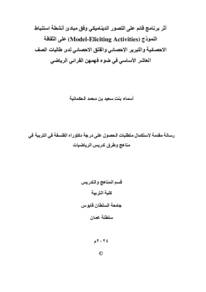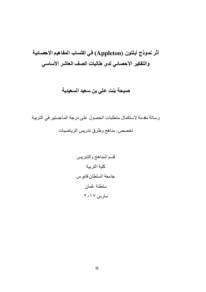وثيقة
أثر برنامج قائم على التصور الديناميكي وفق مبادئ أنشطة استنباط النموذج (Activities Eliciting-Model) على الثقافة الاحصائية و التبرير الاحصائي و القلق الاحصائي لدى طالبات الصف العاشر الأساسي في ضوء فهمهن القرائي الرياضي.
المصدر
رسالة دكتوراة
الدولة
عمان
مكان النشر
مسقط
الناشر
جامعة السلطان قابوس
ميلادي
2024
اللغة
العربية
نوع الرسالة الجامعية
رسالة دكتوراة
الملخص الإنجليزي
The current study aimed to reveal the effect of a program based on
dynamic visualization and the principles of model-eliciting activities
(MEAs) in the statistical literacy, statistical reasoning, and statistical
anxiety of tenth grade students in light of their mathematical reading
comprehension. The implementation of the study required the design of
an educational program based on dynamic visualization according to the
principles of model-eliciting activities to teach the required statistics
content to tenth grade students. A statistical literacy test, statistical
reasoning test, statistical anxiety scale, and mathematical reading
comprehension test were designed; in addition, the reliability and validity
of the study tools were verified before applying them to ensure their
suitability for the purposes of the study.
The study was applied to a purposive sample of (132) female students
from the tenth grade after dividing the sample into two groups: an
experimental group with 68 students who studied using the educational
program, and a control group with 64 students who studied using the
traditional method. After collecting data from the two study groups and
entering it into the SPSS program, then analyzing it using the two-way
analysis of variance (ANCOVA) with a 2X2 factorial design and the
multiple analysis of variance (MANCOVA), the results of the current
study showed:
There is a statistically significant difference (α = 0.05) between the mean
scores of students in the experimental and control groups in the poststatistical literacy test and its levels in favor of the experimental group
except for the third level (The ability to question statistical reports
critically). Additionally, there is no statistically significant difference (α
= 0.05) in the post-statistical literacy test due to the level of mathematical
reading comprehension or to the interaction between the teaching method
and the mathematical reading comprehension of the tenth-grade students.
There is a statistically significant difference (α = 0.05) between the mean
scores of students in the experimental and control groups in the poststatistical reasoning test and its skills in favor of the experimental group
students. There is also a statistically significant difference (α = 0.05) in
the post-statistical reasoning test due to the level of mathematical reading
comprehension in favor of high mathematical reading comprehension
students. While there is no statistically significant difference (α = 0.05) in
the post-statistical reasoning test due to the interaction between the
teaching method and the mathematical reading comprehension of the
tenth-grade students.
There is a statistically significant difference (α = 0.05) between the mean
scores of students in the experimental and control groups in the poststatistical anxiety scale and its dimensions in favor of the experimental
group students, except for the fifth dimension (Computation SelfConcept). Likewise, there is a statistically significant difference (α = 0.05)
in the post- statistical anxiety scale of tenth grade students attributed to
their level of mathematical reading comprehension in favor of high
mathematical reading comprehension students. But there is no statistically
significant difference (α = 0.05) in the post-statistical anxiety due to the
interaction between the teaching method and the mathematical reading
comprehension of the tenth-grade students.
In light of the previous results, the study recommended benefiting from
the educational program applied in this study in developing mathematics
teaching, training teachers on specialized computer software, encouraging
them to use activities that enhance students’ thinking skills such as model-eliciting activities, paying attention to learning statistical reasoning skills,
and enhancing the level of statistical literacy among students.
الملخص العربي
هدفت الدراسة الحالية إلى الكشف عن أثر برنامج قائم على التصور الديناميكي وفق مبادئ أنشطة استنباط النموذج ) Activities Eliciting-Model )على الثقافة الاحصائية، والتبرير الاحصائي، والقلق الاحصائي لدى طالبات الصف العاشر في ضوء فهِمهن .القرائي الرياضي وقد تطلب تنفيذ الدراسة تصميم برنامج تعليمي قائم على التصور الديناميكي وفق مبادئ أنشطة استنباط النموذج وذلك لتدريس محتوى الاحصاء المقرر على طالبات الصف العاشر الاساسي. كما تم تصميم أربع أدوات: اختبار في الثقافة الاحصائية، واختبار في التبرير الاحصائي، واختبار في الفهم القرائي الرياضي، ومقياس للقلق الاحصائي. وجميع هذه الادوات خضعت إلجراءات الصدق والثبات للتأكد من مناسبتها ألغراض الدراسة قبل تطبيقها. وقد تم تطبيق الدراسة على عينة قصدية مكونة من )132( طالبة من طالبات الصف العاشر الاساسي، وذلك بعد تقسيم العينة إلى مجموعتين: تجريبية بها ٦٨ طالبة ودرست باستخدام البرنامج التعليمي، ومجموعة ضابطة بها ٦4 طالبة ودرست بالطريقة الاعتيادية. وبعد جمع البيانات من مجموعتي الدراسة وإدخالها في برنامج )SPSS )ثم تحليلها ب استخدام تحليل التباين الثنائي ال ُمصا ِحب )ANCOVA )ذي التصميم العاملي 2X،2 وتحليل التباين المتعدد ال ُمصا ِحب )MANCOVA)، وقد أظهرت نتائج الدراسة الحالية: يوَجد فرق ذو دلالة إحصائية عندمستوى الدلالة )0,05 = α )بين متوسطات درجات المجموعتين التجريبية والضابطة في التطبيق البعدي لاختبار الثقافة الاحصائية ومستوياته لصالح المجموعة التجريبية باستثناء المستوى الثالث )القدرة على التشكيك في التقارير والرسائل الاحصائية وتقييمها(. وأظهرت النتائج عدم وجود فرق ذو دلالة إحصائية عند مستوى الدلالة )0,05 = α ) د في اختبار الثقافة الاحصائية لدى الطالبات؛ يُ ْعَزى لمستوى الفهم القرائي الرياضي لدي ُه َّن )منخفض ، مرتفع( أو إلى التفاعل بين طريقة التدريس ، والفهم القرائي الرياضي لدى طالبات الصف العاشر الاساسي. •يُو َجدُ فرق ذو دلالة إحصائية عندمستوى الدلالة )0,05 = α )بين متوسطي درجات المجموعتين التجريبية والضابطة في التطبيق البعدي لاختبار التبرير الاحصائي ومهاراته الاربع لصالح يُ ْو َج 0,05 = α )في المجموعة التجريبية. كما دُ فرق ذو دلالة إحصائية عند مستوى الدلالة ) اختبار التبرير الاحصائي لطالبات الصف العاشر يعَزى لمستوى الفهم القرائي الرياضي لديهن لصالح مرتفعات الفهم القرائي الرياضي. بينما لايوجد فرق ذو دلالة إحصائية عند مستوى الدلالة )0,05 = α )في اختبار التبرير الاحصائي يعَزى إلى التفاعل بين طريقة التدريس، والفهم القرائي الرياضي لدى طالبات الصف العاشر الاساسي. •يُ ْو َجدُ فرق ذو دلالة إحصائية عندمستوى الدلالة )0,05 = α )بين متو ِ س َط ْي درجات المجموعتين التجريبية والضابطة في التطبيق البعدي لمقياس القلق الاحصائي وأبعاده لصالح المجموعة يُ ْو َج التجريبية باستثناء البُعد الخامس )مفهوم الذات الحسابي(. كما دُ فرق ذو دلالة إحصائية عند مستوى الدلالة )0.05 = α )في مقياس القلق الاحصائي لطالبات الصف العاشر يُ ْعَزى لمستوى ال يُ ْو َج الفهم القرائي الرياضي لدي ُه ، لصالح مرتفعات الفهم القرائي الرياضي. في حين دُ أث ٌر ذو َّن دلالة إحصائية عند مستوى الدلالة )0,05 = α )في مقياس القلق الاحصائي يُ ْعَزى إلى التفاعل بين طريقة التدريس، والفهم القرائي الرياضي، لدى طالبات الصف العاشر الاساسي. وفي ضوء النتائج السابقة، أوصت الدراسة بالاستفادة من البرنامج التعليمي المطبق في هذه الدراسة في تطوير تدريس الاحصاء، وتدريب المعلمين على البرمجيات الحاسوبية المتخصصة زِ في تدريس الاحصاء، وتشجيعهم على استخدام ُز مهارات التفكير لدى الطلبة الانشطة التي تُعَ م مهارات التبرير الاحصائي، و تعزيز مستوى الثقافة ُّ مثل أنشطة استنباط النموذج، والاهتمام بتعلم مهارات التبريروتعزيز مستوى الثقافة الاحصائية لدى الطلبة.
قالب العنصر
الرسائل والأطروحات الجامعية


